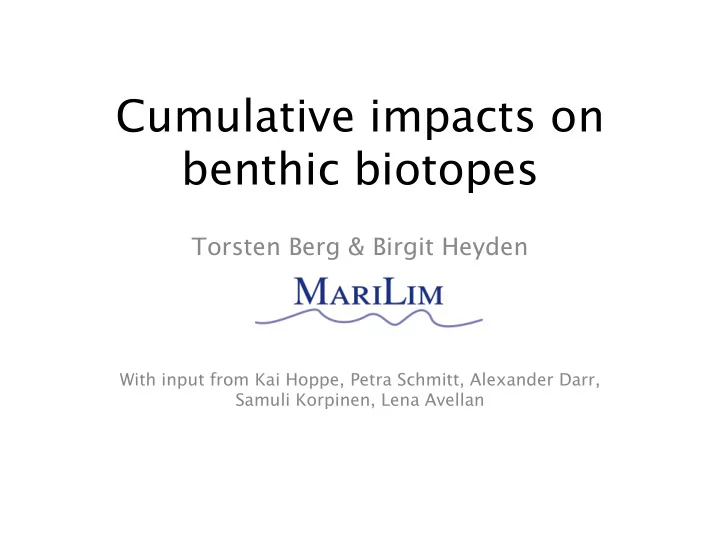

Cumulative impacts on benthic biotopes Torsten Berg & Birgit Heyden With input from Kai Hoppe, Petra Schmitt, Alexander Darr, Samuli Korpinen, Lena Avellan
Basic concept • 2010/477/EU: indicator 6.1.2 • multiple physical pressures on the sea floor (fishing, dredging, disposal, marine structures) • Pressures act together, impacts are cumulative (spatial+ temporal overlaps) • transformation of pressure to impacts
Method • Biotic component: biotope map with sensitivity per pressure • Consider increased sensitivity from oxygen depletion • Overlay sensitivity with magnitude of pressure
Method, simplified
Method, comprehensive
Method, sediment
Method
Method, fishing
Method, biotopes
Cumulation • One map with impact per pressure • Cumulation (if spatial and temporal overlap): – On habitat loss, the degree of impact corresponds to the magnitude of pressure causing the loss – An individual „high“ impact leads to a „high“ cumulative impact
Test settings • Softbottom/infauna biotope map • Fishing intensity from 2013 (no frequency data) • No actual cumulation (fishery is the only pressure) • Usage of vector data (mostly converted from raster data)
Biotopes Biotope map of German Baltic Sea (Schiele et al. 2015) Only soft bottom and infauna data included, HELCOM HUB level 5/6, resolution 1x1 km
Biotope sensitivity 68 biotopes (Schiele, 2015) Biotope sensitivity
Pressures • Fishing (blue grid, sum of surface and subsurface SAR) • Sediment deposition (orange dots, 2km radius) • Dredging (red dots)
Fishing intensity 2013
Fishing impact 2013 CumI BSII
Test results • General impact patterns are credible • SAR scale gives no information on absolute amount of physical damage, e.g. from which point on the scale habitat loss occurs • Resulting impact scale is relative • No correlation to BSII (which is the expected result) • Using multiple pressures, cumulation will only occur in spatially restricted areas – generally fishing pressure is predominant
Recommend
More recommend